Lord of the Flies (1963 film)
8.6 /10 1 Votes
100% Rotten Tomatoes Language English | 7/10 IMDb Budget 250,000 USD Duration Country United Kingdom | |||||||||||||||||||||||||||||||||
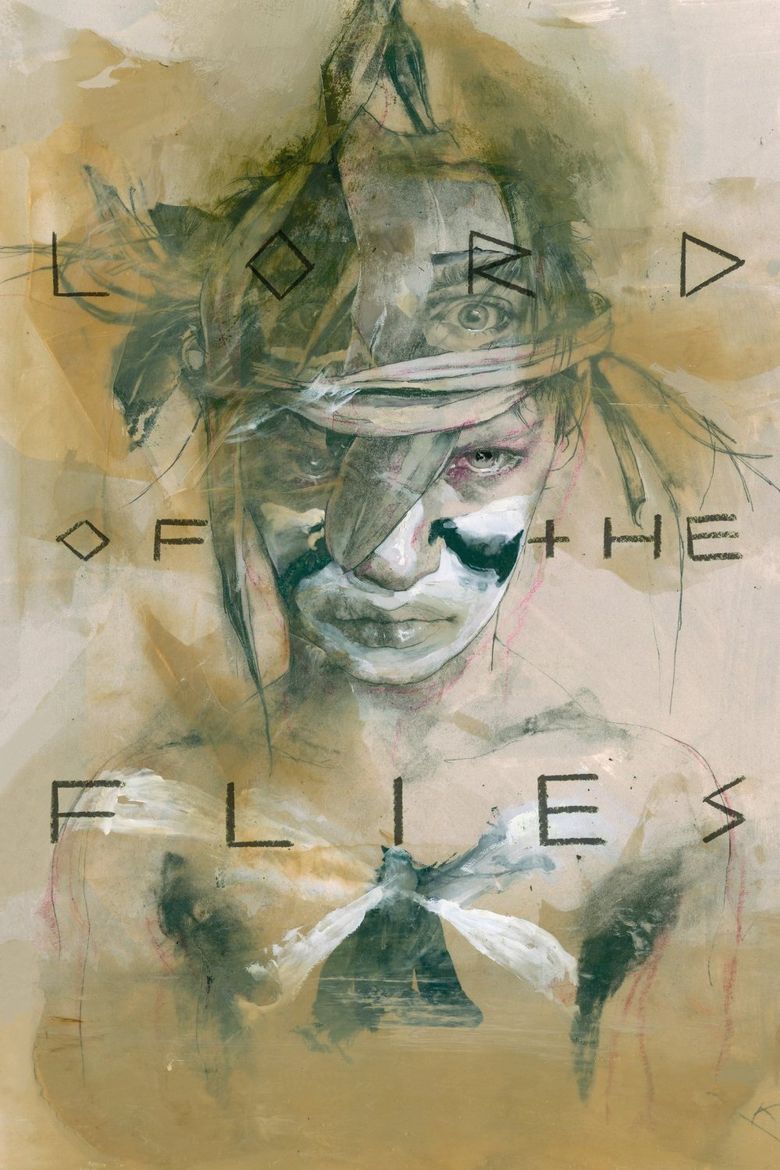 | ||||||||||||||||||||||||||||||||||
Cast (Ralph), Tom Chapin (Jack), Hugh Edwards (Piggy), Roger Elwin (Roger), Tom Gaman (Simon)Similar movies Crusoe , Cast Away , The Blue Lagoon , Return to the Blue Lagoon , Blue Lagoon: The Awakening , Robinson Crusoe Tagline Evil is inherent in the human mind, whatever innocence may cloak it... | ||||||||||||||||||||||||||||||||||
Lord of the Flies is a 1963 British film adaptation of William Golding's novel of the same name about 30 schoolboys who are marooned on an island where they become savages. It was directed by Peter Brook and produced by Lewis M. Allen. The film was in production for much of 1961, though the film was not released until 1963. Golding himself supported the film. When Kenneth Tynan was a script editor for Ealing Studios he commissioned a script of Lord of the Flies from Nigel Kneale, but Ealing Studios closed in 1959 before it could be produced.
Contents

The novel was adapted into a movie for a second time in 1990. The 1963 film is generally more faithful to the novel than the 1990 adaptation.

Plot
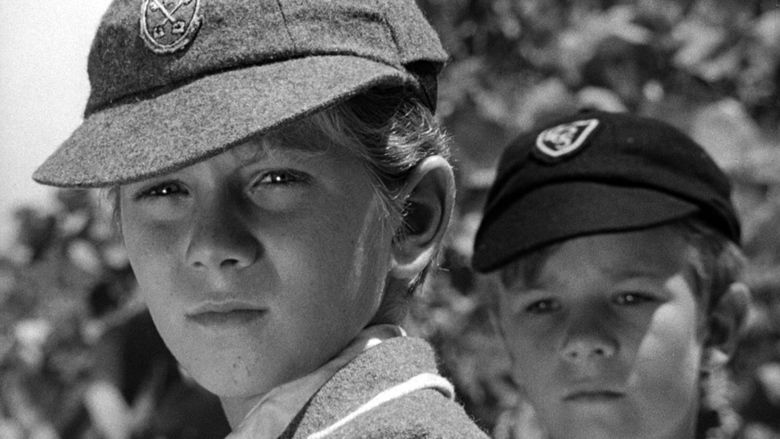
A group of British schoolboys, living in the midst of a war, are evacuated from England. Their airliner is shot down by briefly-glimpsed fighter planes and ditches near a remote island.
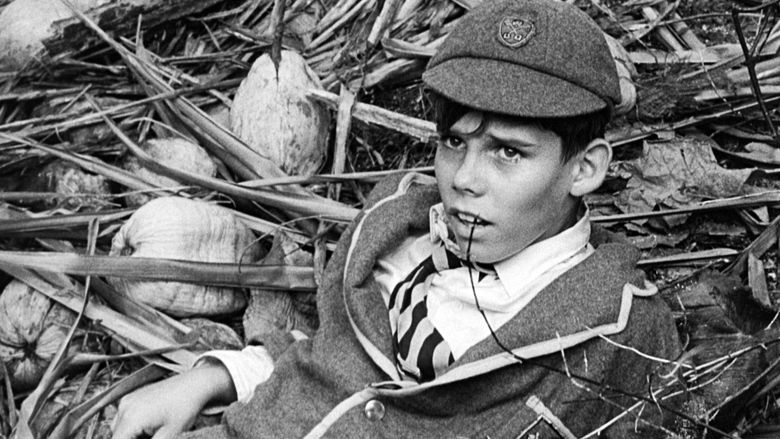
The main character, Ralph, is seen walking through a tropical forest. He meets an intelligent and chubby boy, who reveals his school nickname was Piggy, but asks that Ralph not repeat that. The two go to the beach where they find a conch shell, which Ralph blows to rally the other survivors. As they emerge from the jungle, it becomes clear that no adults have escaped the crash. Singing is then heard and a small column of school choir boys, wearing dark cloaks and hats and led by a boy named Jack Merridew, walk toward their direction.
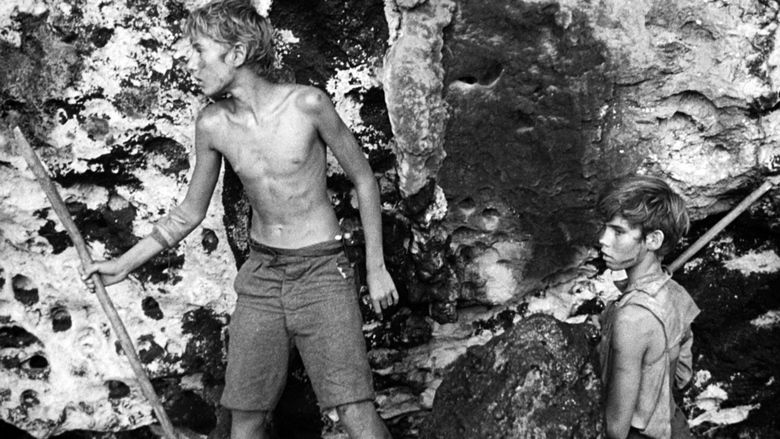
The boys decide to appoint a chief. The vote goes to Ralph, not Jack. Initially, Ralph is able to steer the children (all of whom are aged between about six and fourteen) towards a reasonably civilized and co-operative society. Only the boy holding the conch is allowed to speak in turns during meetings or "assemblies". The choir boys make wooden spears, creating the appearance that they are warriors within the group. Crucially, Jack has a knife, capable of killing an animal.
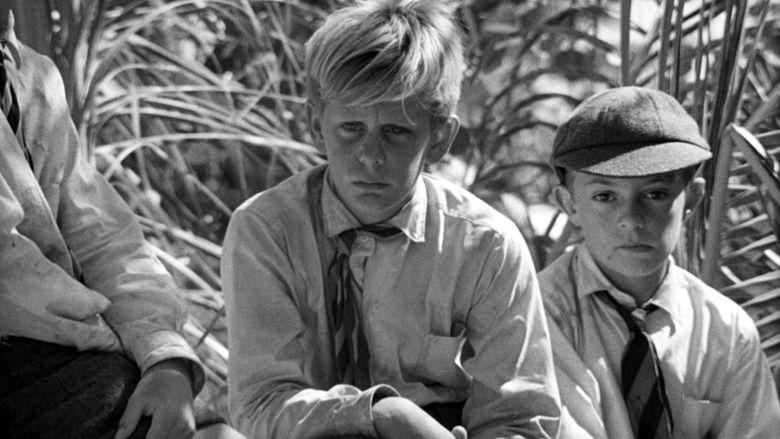
The boys build shelters and start a signal fire using Piggy's glasses. With no rescue in sight, the increasingly authoritarian and violence-prone Jack starts hunting and eventually finds a pig. Meanwhile, the fire, for which he and his "hunters" are responsible, goes out, losing their chance of being spotted from a passing airplane. Piggy chastises Jack, and Jack strikes him in retaliation, knocking his glasses off, and breaking one lens. Ralph is furious with Jack. Soon some of the children begin to talk of a beast that comes from the water. Jack, obsessed with this imagined threat, leaves the group to start a new tribe, one without rules, where the boys play and hunt all day. Soon, more follow until only a few, including Piggy, are left with Ralph.

Events reach a crisis when a boy named Simon finds a sow's head impaled on a stick, left by Jack as an offering to the Beast. He becomes hypnotized by the head, which has flies swarming all around it. Simon goes to what he believes to be the nest of the Beast and finds a dead pilot under a hanging parachute. Simon runs to Jack's camp to tell them the truth, only to be killed in the darkness by the frenzied children who mistake him for the Beast. Piggy defends the group's actions with a series of rationalizations and denials. The hunters raid the old group's camp and steal Piggy's glasses. Ralph goes to talk to the new group using the still-present power of the conch to get their attention. However, when Piggy takes the conch, they are not silent (as their rules require) but instead jeer. Roger, the cruel torturer and executioner of the tribe, pushes a boulder off a cliff and kills Piggy.

Ralph hides in the jungle. Jack and his hunters set fires to smoke him out, and Ralph staggers across the smoke-covered island. Stumbling onto the beach, Ralph falls at the feet of a naval officer who stares in shock at the painted and spear-carrying savages that the children have become, before turning to his accompanying landing party. One of the youngest boys tries to tell the officer his name, but cannot remember it. The last scene shows Ralph sobbing as flames spread across the island.
Theme
As with Golding's book, the pessimistic theme of the film is that fear, hate and violence are inherent in the human condition – even when innocent children are placed in seemingly idyllic isolation. The realisation of this is seen as being the cause of Ralph's distress in the closing shots.
Charles Silver, Curator in the Department of Film at MoMA, wrote that the film is "about anarchy and how that thin veneer we wear of what we refer to as “civilization” is threatened by the attractive clarion call of bestiality and its accompanying hatred".
Filming
The parents of those chosen are reported to have been provided copies of the novel, from which a commentary had been physically removed; those pages included describing the culmination of the hunt of a wild sow as an "Œdipal wedding night". Brook noted that "time was short; we were lent the children by unexpectedly eager parents just for the duration of the summer holidays".
The film was shot entirely in Puerto Rico at Aguadilla, El Yunque and on the island of Vieques. The boys in the cast were all non-professional, had mostly not read the book, and actual scripting was minimal; scenes were filmed by explaining them to the boys, who then acted them out, with some of the dialogue improvised.. Life magazine journalist Robert Wallace visited them there and observed one of them amusing himself by feeding live lizards into the blades of a rotating fan. Wallace commented: "One could almost hear William Golding, 4,000 miles away in England, chuckling into his beard."
The 60 hours of film from the 1961 shoot was edited down to 4 hours, according to editor Gerald Feil. This was further edited down to a 100-minute feature that was shown at the 1963 Cannes Film Festival (9 to 22 May), but the cuts necessitated that new audio transitions and some dialog changes be dubbed into the film more than a year after shooting. The voice of James Aubrey, who played Ralph, had dropped three octaves and was electronically manipulated to better approximate his earlier voice, but it is still significantly different. Tom Chapin, who played Jack, had lost his English accent and another boy's voice was used to dub his parts. The U.S. distributor insisted the film be further edited to 90 minutes, so one fire scene and scenes developing the character Ralph were cut.
The NYC premiere of the film was attended by some of the original cast members followed by a photo shoot in Times Square (picture subsequently published in a Life Magazine article) and a party at Sardi's attended by others such as Zero Mostel.
In 1996, Peter Brook organised a reunion for the cast members for a documentary film called Time Flies. Brook was "curious to know what the years had done to his cast, and what effect the isolated months of filming had had on their lives". Although none seemed damaged by their time working on the film, Simon Surtees, one of a pair of twin brothers who played Sam and Eric, "put his finger unerringly on the ethical dilemma. The problem is that most of us are not trained artists, so I now believe Peter runs the risk of abandoning us to our fate, just as he did in 1961, when he plucked us from our schools and our homes, put us on the island, then cast us back to live our lives as if nothing would ever change."
Tom Gaman, who played Simon in Brook's film, remembered that "although I didn't think much about it at the time, in hindsight my death scene scares me. It was night, the spears--those wooden stakes--were quite real. We were excited, brandishing flaming sticks around a bonfire on the beach in a real storm. I really did emerge from the bushes into the center of a raging crowd, screamed in terror, was stabbed by boys with sharpened sticks, and staggered to the water".
Song
The song, heard throughout the film, of the boys singing is Kyrie Eleison which, translated from Greek, means "Lord, have mercy". It is an expression used in a prayer of the Christian liturgy.
Critical response
The film received acclaim from critics. based on 18 reviews collected by Rotten Tomatoes, the film has an overall approval rating of 100% from critics, with an average score of 8.3/10. However, it has a mixed to positive score from the audience, with 63%.
PopMatters journalist J.C. Maçek III wrote "The true surprise in Lord of the Flies is how little these child actors actually feel like 'child actors'. With few exceptions, the acting rarely seems to be forced or flat. This practiced, well-honed craft aids Brook’s vision of a fly on the wall approach that pulls the viewer into each scene."
Bosley Crowther wrote in The New York Times that "the picture made from it by the writer-director Peter Brook is a curiously flat and fragmentary visualization of the original. It is loosely and jerkily constructed, in its first and middle phases, at least, and it has a strangely perfunctory, almost listless flow of narrative in most of its scenes".
Accolades
Peter Brook was nominated for the Golden Palm at the 1963 Cannes Film Festival.
The film was named one of the Top Ten Films of the year in 1963 by the National Board of Review.
Home media
The Criterion Collection released it on DVD and Blu-ray Disc in America and Canada. Janus Films also released the DVD in the UK.
References
Lord of the Flies (1963 film) WikipediaLord of the Flies (1963 film) IMDbLord of the Flies (1963 film) Rotten TomatoesLord of the Flies (1963 film) themoviedb.org
